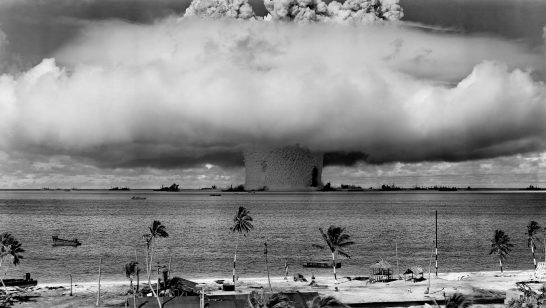
On top of all the other arms control problems that have recently been piling up, we now have a potential crisis regarding the Comprehensive Nuclear-Test-Ban Treaty (CTBT). The annual US Government’s “Compliance Report” for 2020 states that “The United States finds that Russia has conducted nuclear weapons experiments that have created nuclear yield and are not consistent with the US’ ‘zero-yield’ standard.” The Report also expresses “concern” that China may be engaged in the same sort of activity. There are already calls from a few Senators for the US to “unsign” the treaty.
Actually, this issue has been simmering for a long time. For several years, US Compliance Reports have been flirting with the charge that Russia is conducting nuclear weapons-related tests at its Novaya Zemlya test complex. The high-level Congressional Commission on the Strategic Posture of the United States (Perry-Schlesinger Commission) reached consensus in 2009 on all questions except what to do about the CTBT. In the report, opponents of the CTBT charged that “apparently Russia and possibly China are conducting low-yield [nuclear] tests.” No evidence for this charge was presented in the report. In a stronger statement that same year, former CIA Director James Woolsey wrote that “Moscow is irrefutably doing hydrodynamic and hydronuclear experiments at Novaya Zemlya. . .” Again, no evidence was presented. Russian Deputy Foreign Minister Sergey Ryabkov has recently refuted the US charges by saying that Russia is not deviating from its obligations related to the CTBT. He did not, however, clearly spell out what Moscow believes these obligations are. This all has disturbing echoes of the INF disaster, with years of vague US charges without presenting any evidence, followed by Russian denials which seem categorical but are not entirely satisfying. It is possible, of course, that the classified version of the Compliance Report clarifies the US view of the situation.
Status of the Treaty
The CTBT was negotiated by the Conference on Disarmament in Geneva 1994-1996. It has been signed by 184 countries and ratified by 168, both impressive numbers. It was aptly described by President Clinton as the “longest sought, hardest fought” arms control agreement. It has been signed by all of the P-5 countries and ratified by Russia, the UK and France. Eight more countries must ratify for entry into force (EIF)—the US, China, Egypt, Israel, Iran, India, Pakistan and North Korea. The treaty is much more than a piece of paper. The Comprehensive Nuclear Test Ban Treaty Organization Preparatory Commission (CTBTO) in Vienna has been hard at work for over 20 years. It has almost completed a remarkable International Monitoring System (IMS) with 337 facilities in 89 countries. Data from this system is flowing to all the signatory states and are useful for many scientific and humanitarian purposes beyond treaty verification. Extensive field exercises to test the on-site inspection provisions of the treaty have been conducted in Kazakhstan and Jordan.
The current legal status of the treaty in the period between signature and EIF is determined by the Vienna Convention on the Law of Treaties. This provides that states that have signed must not engage in activities that would “defeat the object and purpose” of the treaty. A further complication is that all states that have conducted nuclear weapons explosions in the past, except for North Korea, have entered into unilateral, voluntary moratoria on conducting nuclear explosions. North Korea has not conducted a test since 2017. There are thus rather complicated legal and technical issues regarding whether states are complying with these “obligations” and “standards.”
What is the fundamental legal obligation in the CTBT?
This is the so-called “scope” issue, which has been of interest in some quarters for a long time. The treaty prohibits any “nuclear explosion,” but does not define that term. This was deliberate and not an oversight. Although the START and New START Treaties contain a large number of carefully crafted definitions, the NPT does not even define “nuclear weapon.” This has not been a problem, although greater clarity in exactly where the red line is between peaceful nuclear activities and those leading to nuclear weapons would have been helpful–for example, in dealing with Iran’s nuclear programs. In any case, the CTBT negotiating record, together with testimony given in the ratification hearings in the key countries, indicate that the negotiators believed that there was no problem with this situation and there was a general agreed understanding of the treaty’s key obligation. To avoid future misunderstandings, it was recognized that there would be certain “activities not prohibited,” which included work on inertial confinement fusion, certain scientific research involving some release of nuclear energy, and so on. The list also included recognition that there could be experiments on small amounts of fissile material which do not involve a self-sustaining nuclear reaction—i.e., going supercritical. These are known as hydrodynamic tests. This clarification was noted in the US Government’s article-by-article analysis of the treaty. It also noted the list is not exhaustive.
Unfortunately, the popular term “yield” has been used repeatedly, especially by political leaders, in describing the obligation as being “zero-yield.” This has the danger of creating some confusion since a search of the literature can produce different understandings of this concept. The US has been clear and generally believes that other countries agree, that “hydrodynamic” tests on fissile material are allowed, while “hydronuclear” tests are not. This issue has been discussed extensively elsewhere and will not be pursued further here.
What would defeat the object and purpose of the Treaty?
As noted above, in the no man’s land between signature and EIF, countries that have signed the treaty are not legally governed by the literal treaty text itself, but by an obligation to avoid activities that would defeat its object and purpose. The question immediately arises, would a small number of very small tests which do produce a nuclear “yield” violate this obligation? The US has given an unequivocal response that it would so violate. If “defeat the object and purpose” has its commonsense meaning of making implementation of the treaty impossible, one could note that India, Pakistan and North Korea, whose ratification is essential for EIF, all conducted full-scale nuclear weapons tests after the treaty was opened for signature. This obviously did not make implementation impossible and all three would be welcomed into the CTBT family. Perhaps a distinction could be made between actions “inconsistent” with the object and purpose of the treaty and those which would actually defeat it.
The Vienna Convention also provides that the “object and purpose” obligation may be lifted if EIF is “unduly delayed.” The delay is 24 years and counting.
What is the obligation in the worldwide moratorium?
This complicates the situation even further. The worldwide moratorium on nuclear explosions is a set of voluntary, non-binding unilateral commitments. This is very useful and appears to be holding. In its 2018 Nuclear Posture Report, the Trump administration declared that it will not ratify the CTBT, but does support the moratorium and urges all countries to abide by it. As noted above, even North Korea appears to be abiding by a moratorium. However, the question does arise, a moratorium on what? No agreed document defines where each country thinks its red line is. Thus, the charge in the US Compliance Report that Russia is not abiding by the US standard seems curious. Why would Russia necessarily be abiding by the US standard? One would hope that the Russian standard and the US standard would be identical, along with those of all the other relevant countries, but we are not talking about legal obligations here. Clearly, the US standard should be the gold standard, but why has there not been any international negotiation about this?
Solutions
The US Compliance Report forces into the open issues that have been present beneath the surface for a long time. These issues threaten to damage an overall arms control regime already suffering from multiple controversies. It also calls into question the very valuable worldwide moratorium on nuclear explosions. There have been no nuclear explosions anywhere in the world since 2017 and no such explosions by any country except North Korea since 1998. Whether or not one supports the CTBT, all countries should support the continuation of this situation.
It appears that all countries agree on the meaning of the basic obligations contained in the CTBT. If any key country has doubts about that, some discussion of the situation at an appropriately high level might be in order. It is also possible that countries have differing understandings of the “object and purpose” criterion, or of what obligations they are undertaking in their unilateral moratoria. In that case, it is possible that a country could believe that certain activities that will be prohibited after the treaty enters into force may not be prohibited now before EIF. It is also possible that a country’s interpretation of its obligations could have evolved during the long wait for EIF. That could explain the current misunderstanding.
The solution to all this does not seem difficult. There have long been calls for greater transparency regarding activities at test sites. In particular, Russia could explain what it is doing at Novaya Zemlya. The US has been quite open about its hydrodynamic tests in Nevada. Similar transparency regarding the other issues raised above would also not be difficult or compromise national security. Even if it turns out that there are differences in interpretation of certain terms, these would appear to be relatively minor and susceptible to negotiation. One consideration might be that, when we negotiated the treaty, there was no expectation that the difference between hydrodynamic tests and very small hydronuclear tests would be detected by either the IMS or any reasonable application of on-site inspection, especially if such tests were conducted in solid containment chambers. This would appear to be a suitable subject for the P-5, who may meet in New York in September.
The opinions articulated above represent the views of the author(s) and do not necessarily reflect the position of the European Leadership Network or any of its members. The ELN aims to encourage debates that will help develop Europe’s capacity to address the pressing foreign, defence, and security policy challenges of our time.
Image: First CTBT on-site inspection activity at the former Nevada Test. Flickr, The Official CTBTO Photostream


